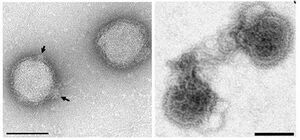Globuloviridae: Difference between revisions
No edit summary |
|||
| (6 intermediate revisions by 2 users not shown) | |||
| Line 1: | Line 1: | ||
{{Uncurated}} | {{Uncurated}} | ||
[[Image: | [[Image:OIP.jpeg|thumb|300px|right|The bars represent 100 nm. Modified from (Häring et al., 2004; provided by ICTV).]] | ||
| Line 9: | Line 9: | ||
Family: Globuloviridae | |||
Genus: Alphaglobulovirus | |||
===Species=== | ===Species=== | ||
Alphaglobulovirus cinderense | |||
Alphaglobulovirus obsidianense | |||
Alphaglobulovirus pozzuoliense | |||
Alphaglobulovirus sileriense | |||
==Description and Significance== | ==Description and Significance== | ||
| Line 40: | Line 37: | ||
==Cell Structure, Metabolism and Life Cycle== | ==Cell Structure, Metabolism and Life Cycle== | ||
Cell Structure: | |||
Virions are single molecule of linear dsDNA, comprising 28,337 bp for Pyrobaculum spherical virus (PSV). They are are spherical, 70–100 nm in diameter, with spherical protrusions that are about 15 nm in diameter. Amino acids are hydrophobic and virions are oxygen and heat-stable. | |||
Metabolism: | Metabolism: | ||
The virion integrates into the host cell's metabolism via passive diffusion in water. Pyrobaculum and Thermoproteus archaea are common host organisms. The virion is not responsible for encoding genome replication proteins, and is instead responsible for the recruitment of host cell machinery. | The virion integrates into the host cell's metabolism via passive diffusion in water. Pyrobaculum and Thermoproteus archaea are common host organisms. The virion is not responsible for encoding genome replication proteins, and is instead responsible for the recruitment of host cell machinery. | ||
Life Cycle: | |||
PSV infects hyperthermophilic archaea from the genera Pyrobaculum and Thermoproteu hosts: anaerobes thriving in extreme geothermal environments with temperatures around 85 °C, pH 6. Globuloviruses establish a chronic infection and are released from the host cells without causing lysis. The viral genome does not integrate into the host chromosome. | |||
==Ecology And Pathogenesis== | ==Ecology And Pathogenesis== | ||
| Line 59: | Line 64: | ||
Prangishvili , D. and Krupovic, M. (2018) ICTV. Edited by A.M. Kropinski and S.G. Siddell. Available at: https://ictv.global/report/chapter/globuloviridae/globuloviridae (Accessed: 20 November 2024). | Prangishvili , D. and Krupovic, M. (2018) ICTV. Edited by A.M. Kropinski and S.G. Siddell. Available at: https://ictv.global/report/chapter/globuloviridae/globuloviridae (Accessed: 20 November 2024). | ||
ViralZone. Virus Properties [Internet]. Available from: https://viralzone.expasy.org/535 | |||
==Author== | ==Author== | ||
Latest revision as of 03:47, 4 December 2024
Classification
Family: Globuloviridae
Genus: Alphaglobulovirus
Species
Alphaglobulovirus cinderense
Alphaglobulovirus obsidianense
Alphaglobulovirus pozzuoliense
Alphaglobulovirus sileriense
Description and Significance
The Globuloviridae family comprises spherical, enveloped viruses with linear, double-stranded DNA genomes ranging from 21 to 28 kilobase pairs. These viruses infect hyperthermophilic archaea, specifically the genera Pyrobaculum and Thermoproteus, which thrive in extreme geothermal environments. The virions are about 70-100 nm in diameter and feature a lipid-containing envelope and a helical nucleoprotein core. Notably, globuloviruses do not cause the lysis of their host cells, and their genomes do not integrate into the host’s chromosome. The significance of Globuloviridae lies in their role in the ecology of extreme environments and their contribution to our understanding of virus-host interactions under extreme conditions. Studying these viruses can provide insights into the limits of life on Earth and the potential for life in similar extreme environments elsewhere in the universe.
Genome Structure
Globuloviridae have a genome size of roughly 21,000 to 28,000 base pairs and contain between 38 and 48 open reading frames depending on specific species. Only 15 open reading frames are shared between the Pyrobaculum and Thermoproteus Tenax spherical virus species. The genome consists of linear double stranded DNA. There are only three types of main structural proteins encoded in its genome.
Cell Structure, Metabolism and Life Cycle
Cell Structure:
Virions are single molecule of linear dsDNA, comprising 28,337 bp for Pyrobaculum spherical virus (PSV). They are are spherical, 70–100 nm in diameter, with spherical protrusions that are about 15 nm in diameter. Amino acids are hydrophobic and virions are oxygen and heat-stable.
Metabolism:
The virion integrates into the host cell's metabolism via passive diffusion in water. Pyrobaculum and Thermoproteus archaea are common host organisms. The virion is not responsible for encoding genome replication proteins, and is instead responsible for the recruitment of host cell machinery.
Life Cycle:
PSV infects hyperthermophilic archaea from the genera Pyrobaculum and Thermoproteu hosts: anaerobes thriving in extreme geothermal environments with temperatures around 85 °C, pH 6. Globuloviruses establish a chronic infection and are released from the host cells without causing lysis. The viral genome does not integrate into the host chromosome.
Ecology And Pathogenesis
Habitat:
Globuloviridae are hyperthermophiles who lives in environments of around 85 C (~185F) with a pH of 6. They are strict aerobes, who live in only oxygenated environments.
Pathogenesis:
Globuloviridae infect archaea living in similar geothermal environments, more specifically, the genera of Pyrobaculum and Thermoproteus. They travel through passive diffusion, and when it infects its host, it does not cause lysis. Instead it will stay and establish a chronic infection. It has not been noted to use its host’s machinery, nor does it integrate into its chromosome. It does not have any information regarding human infection, nor is there any antiviral able to treat this virus.
References
Prangishvili , D. and Krupovic, M. (2018) ICTV. Edited by A.M. Kropinski and S.G. Siddell. Available at: https://ictv.global/report/chapter/globuloviridae/globuloviridae (Accessed: 20 November 2024).
ViralZone. Virus Properties [Internet]. Available from: https://viralzone.expasy.org/535
Author
Page authored by Jordan Scott, Andrew Edwards, Jayde Walker, & Taylor Houston, students of Prof. Bradley Tolar at UNC Wilmington.

